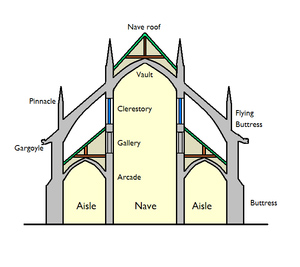Basilica

|
| A typical Basilica-type plan form showing central nave, side aisles and apsed end. |
The term basilica is derived from the Latin which itself derives from the Greek βασιλικ στο or Royal Stoa.
Over the centuries, three meanings of the word basilica have come into usage to describe:
- An ancient Roman public building;
- A particular church typology based on a rectangular plan with aisles and naves which became popular in Europe and America and is still widely in evidence. From the 4th century, the idea of adding an apse to one or both ends became fairly common.
- A large, important Catholic church that has special ceremonial rights conferred on it by the Pope.
The Romans used the word Basilica to refer to their public buildings, whether those for justice, business or exchange. Although they were not used for religious purposes, any self-respecting city would not be without one.
These buildings would have a rectangular plan divided by parallel colonnades to form one or two arcades and therefore aisles either on one or two sides and a central nave. At one end there would be a semi-circular apse that would be used as the tribunal, which was where the ruler or magistrate would sit to administer justice. Above the arcades there might be a meeting room. The central aisle (nave) tended to be wider than the side aisle or aisles. It was also higher to allow the insertion of clerestory windows for natural light.
Buildings of this type would later be converted for Christian worship and some retained the name eg St George’s Basilica. The term is still encountered today.

|
| Schematic of a basilica-type Christian church with nave and aisles. |
Although the basic plan underwent successive variations, Catholic and Protestant churches would generally continue to follow the basic form, namely, a rectangular hall, a wide nave (sometimes central) and one or two side aisles.
Romanesque and Gothic cathedrals deviated from the original basilica form with their cruciform plan and tower over the crossing of the main body with the transept but generally still displayed the core constituents of colonnades, nave and aisles.
[edit] Related articles on Designing Buildings Wiki
Featured articles and news
Latest Build UK Building Safety Regime explainer published
Key elements in one short, now updated document.
UKGBC launch the UK Climate Resilience Roadmap
First guidance of its kind on direct climate impacts for the built environment and how it can adapt.
CLC Health, Safety and Wellbeing Strategy 2025
Launched by the Minister for Industry to look at fatalities on site, improving mental health and other issues.
One of the most impressive Victorian architects. Book review.
Common Assessment Standard now with building safety
New CAS update now includes mandatory building safety questions.
RTPI leader to become new CIOB Chief Executive Officer
Dr Victoria Hills MRTPI, FICE to take over after Caroline Gumble’s departure.
Social and affordable housing, a long term plan for delivery
The “Delivering a Decade of Renewal for Social and Affordable Housing” strategy sets out future path.
A change to adoptive architecture
Effects of global weather warming on architectural detailing, material choice and human interaction.
The proposed publicly owned and backed subsidiary of Homes England, to facilitate new homes.
How big is the problem and what can we do to mitigate the effects?
Overheating guidance and tools for building designers
A number of cool guides to help with the heat.
The UK's Modern Industrial Strategy: A 10 year plan
Previous consultation criticism, current key elements and general support with some persisting reservations.
Building Safety Regulator reforms
New roles, new staff and a new fast track service pave the way for a single construction regulator.
Architectural Technologist CPDs and Communications
CIAT CPD… and how you can do it!
Cooling centres and cool spaces
Managing extreme heat in cities by directing the public to places for heat stress relief and water sources.
Winter gardens: A brief history and warm variations
Extending the season with glass in different forms and terms.
Restoring Great Yarmouth's Winter Gardens
Transforming one of the least sustainable constructions imaginable.






















